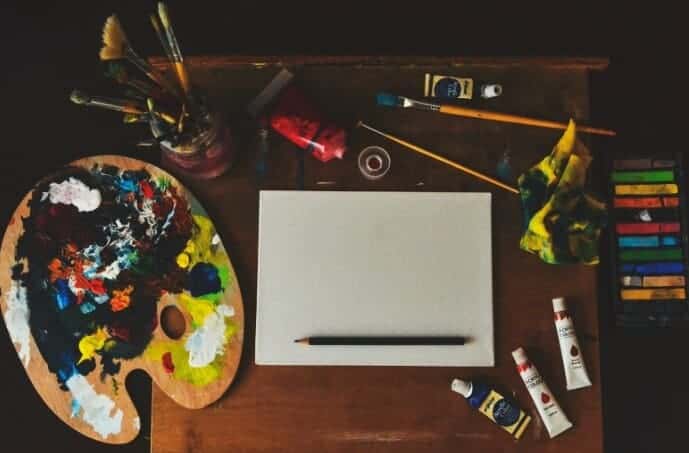
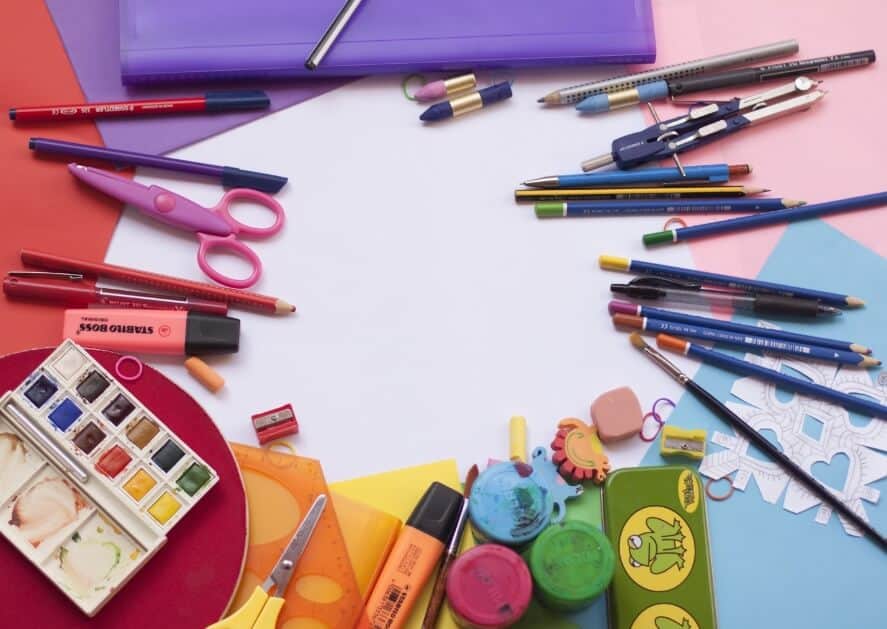
Unit 09 :
Painting and Drawing 繪畫類



Vocabulary
Let’s learn about different vocabulary in paintings.
Part 1
1. doodle/ˈduː.dəl/
(v.)(心不在焉或心煩時)隨手亂畫
to draw pictures or patterns while thinking about something else or when you are bored
She’d doodled all over her textbooks.
她在課本上到處隨手亂畫。
2. sketch /sketʃ/
(n.)草圖,速寫;素描
a simple, quickly-made drawing that does not have many details
(v.)(給…)畫素描;(爲…)畫草圖
to make a sketch of something
When I have some spare time, I like to sketch.
有空閒的時候,我喜歡畫素描。
3. graffiti /ɡrəˈfiː.t̬i/
(n.)(尤指寫畫在公共場合的牆或門上的幽默的、粗野的或政治性的)塗鴉,圖畫
words or drawings, especially humorous, rude, or political, on walls, doors, etc. in public places
The subway walls are covered with graffiti.
過街地道的牆上滿是塗鴉。
4. illustration/ˌɪl.əˈstreɪ.ʃən/
(n.)插圖;圖解,圖示
a picture in a book, magazine, etc. or the process of illustrating something
a full-page illustration 一幅整頁的插圖
color/black and white illustrations 彩色/黑白插圖
5. outline /ˈaʊt.laɪn/
(n.)輪廓,略圖,外形
the main shape or edge of something, without any details
(v.)勾勒,描畫…的輪廓
to draw the main shape or edge of something
She drew the outline of the boat and then colored it in.
她畫了這隻船的草圖,然後給它著色。
6. canvas /ˈkæn.vəs/
(n.)油畫布;油畫
a piece of this cloth used by artists for painting on, usually with oil paints, or the painting itself
7. watercolor/ˈwɑː.t̬ɚˌkʌl.ɚ/
(n.)水彩(顏料);水彩畫
a paint that is mixed with water and used to create pictures, or a picture that has been done with this type of paint
I prefer painting with watercolors.
我更喜歡水彩畫。
8. brush /brʌʃ/
(n.)刷子;畫筆
an object with short pieces of stiff hair, plastic, or wire attached to a base or handle, used for cleaning, arranging your hair, or painting
(v.)(用刷子或手)拂;撣;擦掉
to move something somewhere using a brush or your hand
a scrub brush 硬毛刷
a pastry brush 軟毛刷
9. palette/ˈpɔːr.trɪt/
(n.)調色板
a thin board with curved edges and a hole for your thumb, used by artists to mix their paints on while they are painting
10. collage/ˈkɑː.lɑːʒ/
(n.)拼貼畫;拼貼藝術
a picture in which various materials or objects, for example, paper, cloth, or photographs, are stuck onto a larger surface
The children made a collage of postcards.
孩子用明信片製作了一幅拼貼畫。
Exercise 1
Describe to your tutor what you see in this pictures.
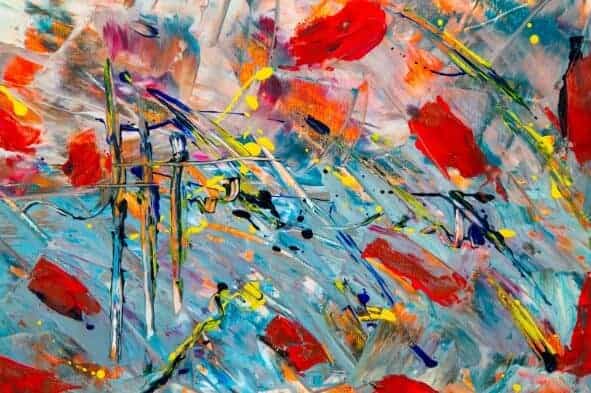
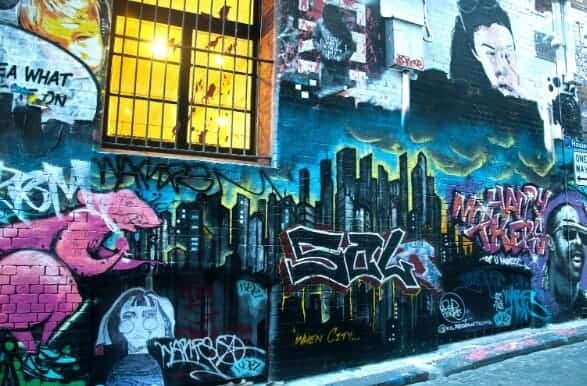
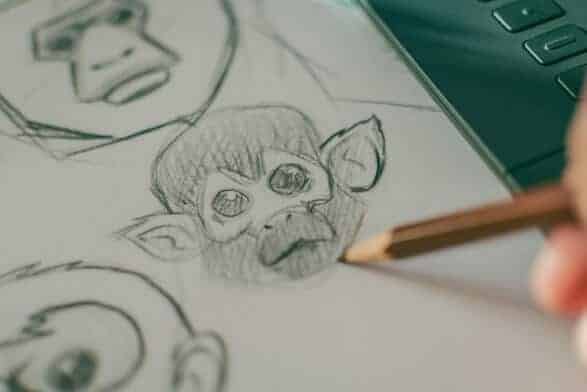
Part 2
11. lithograph /ˈlɪθ.oʊ.ɡræf/
(n.)平版印刷畫,石版畫
a picture printed using a stone or metal block on which an image has been drawn with a thick substance that attracts ink
12. woodcut/ˈwʊd.kʌt/
(n.)木刻;木版畫
a picture printed from a pattern that has been cut in the surface of a block of wood
13. perspective/pɚˈspek.tɪv/
(n.)透視(畫)法
the way that objects appear smaller when they are further away and the way parallel lines appear to meet each other at a point in the distance
In 15th-century Italy, artists rediscovered the rules of perspective.
在15世紀的義大利,藝術家重新發現了透視規則。
14. symmetry /ˈsɪm.ə.tri/
(n.)對稱(性);勻稱
the quality of having parts that match each other, especially in a way that is attractive, or similarity of shape or contents
15. contrast /ˈkɑːn.træst/
(n.)(v.)差別,差異;對照,對比
an obvious difference between two or more things
There’s a marked contrast between his character and hers.
他的性格與她形成了鮮明對比。
16. deconstruction/ˌdiː.kənˈstrʌkʃ.ən/
(n.)結構分解,解構(將事物的各方面分開以了解其含義,尤指顛覆人們對該事物的傳統理解)
the act of breaking something down into its separate parts in order to understand its meaning, especially when this is different from how it was previously understood
17. harmony/ˈhɑːr.mə.ni/
(n.)協調,和諧,一致
a situation in which people are peaceful and agree with each other, or when things seem right or suitable together
racial harmony 種族和諧
domestic harmony 家庭和睦
18. emphasis /ˈem.fə.sɪs/
(n.)重視;強調
the particular importance or attention that is given to something
I think we should put as much emphasis on preventing disease as we do on curing it.
我認爲我們應該像重視治療一樣重視疾病的預防。
19. proportion /prəˈpɔːr.ʃən/
(n.)(某物各個組成部分或一物與另一物之間的)相稱,協調,均衡,勻稱
the correct or most attractive relationship between the size of different parts of the same thing or between one thing and another
His feet seem very small in proportion to his body.
和他的身體相比,他的腳似乎顯得太小了。
20. composition/ˌkɑːm.pəˈzɪʃ.ən/
(n.)(繪畫或照片的)構圖,構思,佈局
the way that people or things are arranged in a painting or photograph
a group composition 組合構思
Exercise 2
Match the correct meaning to each vocabulary.
- emphasis __ 2. contrast __ 3. woodcut __ 4. composition __ 5. harmony __
a. the way that people or things are arranged in a painting or photograph
b. a picture printed from a pattern that has been cut in the surface of a block of wood
c. the particular importance or attention that is given to something
d. a situation in which people are peaceful and agree with each other, or when things seem right or suitable together
e. an obvious difference between two or more things
Part 3
21. chiaroscuro /kiˌɑːr.əˈskjʊr.oʊ/
(n.)(繪畫中的)明暗對照法
the use of areas of light and darkness in a painting
22. impressionism/ɪmˈpreʃ.ən.ɪ.zəm/
(n.)印象主義,印象派(源於19世紀60年代法國的一種繪畫風格,試圖表現物體、人物、鄉村景物等的光線作用效果)
a style of painting, which began in France in the 1860s, in which the artist tries to represent the effects of light on an object, person, area of countryside, etc.
23. naturalism/ˈnætʃ.ɚ.əl.ɪ.zəm/
(n.)(藝術和文學中的)自然主義
showing people and experiences as they really are, instead of suggesting that they are better than they really are or representing them in a fixed style
24. expressionism/ɪkˈspreʃ.ən.ɪ.zəm/
(n.)(藝術、音樂或文學中的)表現主義
a style of art, music, or writing, found especially in the 1900s, that expresses extreme feelings
25. modernism/ˈmɑː.dɚ.nɪ.zəm/
(n.)(尤指藝術上從1920年代至今的)現代派,現代主義
the ideas and methods of modern art, especially from the 1920s until now
26. fauvism /ˈfoˌvɪzəm/
(n.)野獸派An early 20th-century movement in painting begun by a group of French artists and marked by the use of bold, often distorted forms and vivid colors.
27. surrealism/səˈrɪə.lɪ.zəm/
(n.)超現實主義(20世紀的一個文藝流派)
a type of 20th-century art and literature in which unusual or impossible things are shown happening
28. academicism/͵ækəˋdɛmə͵sɪzəm/
(n.)學院派;學院風氣
a style of painting, sculpture, and architecture produced under the influence of European academies of art.
29. pointillism /ˈpwæn.tə.lɪ-/
(n.)(19世紀末興起於法國的)點描畫法
a style of painting developed in France at the end of the 19th century in which a painting is created out of small spots of pure color that seem to mix when seen from far away
30. aestheticism/esˈθetiˌsizəm/
(n.)唯美主義
an intellectual and art movement supporting the emphasis of aesthetic values more than social-political themes for literature, fine art, music, and other arts.
Exercise 3
Describe to your tutor what you see in this pictures.
